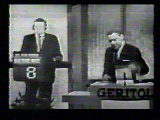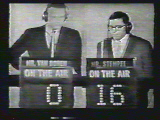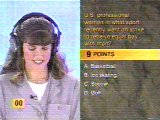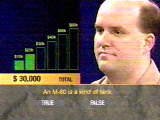Twenty One
From RulesWiki
| TWENTY ONE | |
| Logo and set from the 2000 incarnation. | |
|---|---|
| Airdates: | NBC September 1956 - October 1958, NBC January 2000 - May 2000 |
| Hosts: | Jack Barry, Maury Povich |
| Announcer: | Bill McCord, John Cramer |
| Producer: | Jack Barry and Dan Enright Productions (1956-1958), Phil Gurin Entertainment (2000) |
Contents |
[edit]
Gameplay
[edit]
1956-1958 Version
Two players competed. Both contestants were locked in soundproof booths, so that neither was aware of his opponent's progress. In each round, the host would read a category to the players. The contestants would then choose a question in that category worth between 1-11 points. Questions worth more points were more difficult, and upper level questions sometimes required multiple answers. A correct answer added the value of the question to the player's score, while a wrong answer deducted the value (though a player couldn't go under 0). The player that scored 21 points in the fewest number of rounds won the game and $500 for each point in the margin of victory (e.g. a 21-16 win would score $2,500). In the case of a tie (both players reaching 21 points in the same number of questions), another game was played with the stakes raised another $500 per point. Also, after the second round, the host would give both players the opportunity to stop the game. If either player elected to stop the game, whoever was leading would win. In the case of a tie, play continued as normal.After each win, the champion had to decide whether to stop playing and take the money, or take on a new challenger. If the champion lost, the challenger's winnings would be taken out of the champion's total. A champion could continue playing as long as they continued winning.
[edit]
2000 Version
Gameplay was similar to the 1950s version. In this incarnation, instead of a wrong answer deducting points, it assigned the player a strike; if a player accumulated three strikes, he was eliminated from the game. Also, once per game, a player could bring out a "Second Chance" helper to assist them with the question, but at the risk of receiving two strikes if he answered the "Second Chance" question incorrectly. In the case of a tie, a sudden death toss-up question was asked. In the first few episodes, players won $100,000 in their first game, $200,000 in the second, and so on for four games, at which point the payouts reset. Later on, the payouts were adjusted as such: First game, $25K; Second game, $50K; Third game, $100K; Fourth, $250K; Fifth, $500K; Sixth, $750K; Seventh, $1M; at which point it reset. If a player lost their first game, they took home a $1,000 consolation prize. Champions continued to play until defeated.
New challengers were chosen originally by an audience vote between three candidates, and then by random draw. Six prospective challengers were introduced at the start of each episode, and would remain in waiting until their name was called.
[edit]
Notes
- The 1950s version is most known for its role in the quiz show scandals, which came to a head in a match between former GI Herb Stempel and Columbia professor Charles Van Doren. Their match lasted for a total of five games, until Van Doren finally defeated Stempel by a score of 18-10. Stempel left the show with a total of $49,500 in winnings, while Van Doren would eventually win over $120,000. However, Stempel would help expose the fact that both he and Van Doren - not to mention many other contestants on the show - had been coached by the producers both with the answers and how to play the game. The fallout from these scandals tarnished the genre for years, effectively exiled Barry and Enright from TV work for well over a decade, and resulted in the creation of Standards and Practices departments in each network to prevent such a debacle from happening again. The story of Herb Stempel and Charles Van Doren was the basis for the 1994 film Quiz Show.
- The 2000 version created two millionaires. In February, Harvard law student Rahim Oberholtzer won $1,120,000 in four games. Three weeks later, Oberholtzer was dethroned by Lt. David Legler's $1,765,000.







